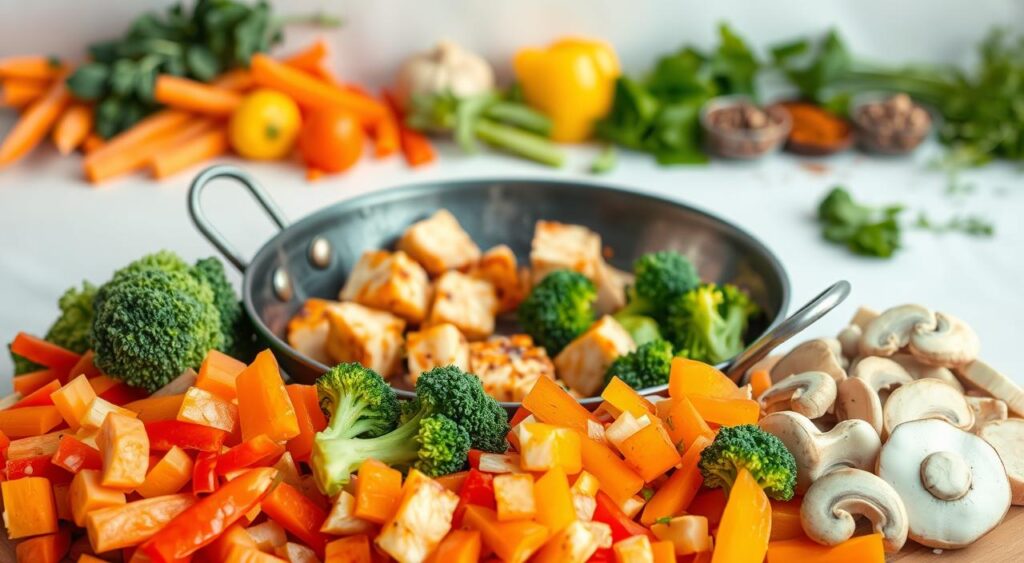Are you looking for a nutritious meal that doesn’t sacrifice flavor or health benefits? Stir fry dinners are the perfect solution for busy weeknights. You can get your protein, veggies, and everything in one skillet, all within 20 minutes.
Stir frying is a quick cooking method that preserves nutrients in vegetables and proteins, supporting gut health. By incorporating gut-friendly ingredients into your stir fry recipes, you can create balanced meals that are both delicious and nutritious.
Discover how to adapt stir fry techniques to accommodate different dietary needs while supporting gut health. You’ll learn how to create recipes that reduce inflammation, support beneficial gut bacteria, and improve overall digestive function.
Key Takeaways
- Learn how to create balanced stir fry meals that incorporate gut-friendly ingredients.
- Discover 9 powerful foods that naturally enhance gut health.
- Understand how stir frying preserves nutrients in vegetables and proteins.
- Adapt stir fry techniques to accommodate different dietary needs.
- Improve overall digestive function with the right combination of ingredients.
The Connection Between Stir Fry and Gut Health
Stir fry, a cooking method known for its speed and versatility, plays a significant role in maintaining gut health. The high-heat, quick cooking process involved in stir frying helps preserve vital nutrients that are often lost in longer cooking methods.
Why Quick Cooking Preserves Nutrients
Stir frying vegetables for just a few minutes retains water-soluble vitamins and antioxidants, supporting gut barrier function. The minimal cooking time ensures that fiber in vegetables remains intact, providing essential prebiotics for beneficial gut bacteria. This method is particularly effective due to the high heat used, which quickly cooks the ingredients.
How Stir Fry Supports Digestive Wellness
The stir fry method allows for a diverse range of vegetables to be incorporated into one dish, promoting microbiome diversity. By combining proteins, vegetables, and aromatic ingredients, stir fry provides comprehensive support for digestive processes. The versatility of fry techniques enables the inclusion of anti-inflammatory ingredients that can help calm digestive distress, making it an accessible way to support gut health regularly. The act of fry cooking, when done correctly, retains the nutrients, and the stir action ensures even cooking.
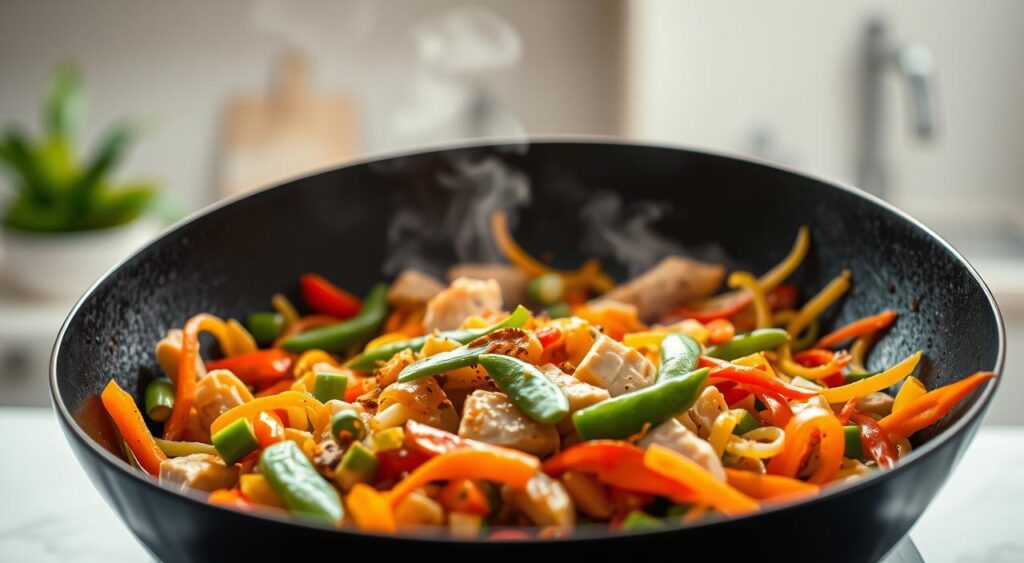
9 Gut-Boosting Foods to Include in Your Quick and Healthy Stir Fry
Discover the top 9 gut-boosting foods that can transform your stir fry into a digestive wellness powerhouse. Incorporating these ingredients into your diet can lead to a healthier, happier gut.
Fiber-Rich Vegetables
Fiber-rich vegetables are essential for a gut-friendly stir fry. Broccoli stands out as a gut health superstar, containing sulforaphane that supports detoxification pathways and reduces inflammation. Other beneficial vegetables include carrots, which provide beta-carotene and soluble fiber, and bell peppers, rich in vitamin C and antioxidants. You can also add snow peas and green beans for digestible fiber that promotes regularity.
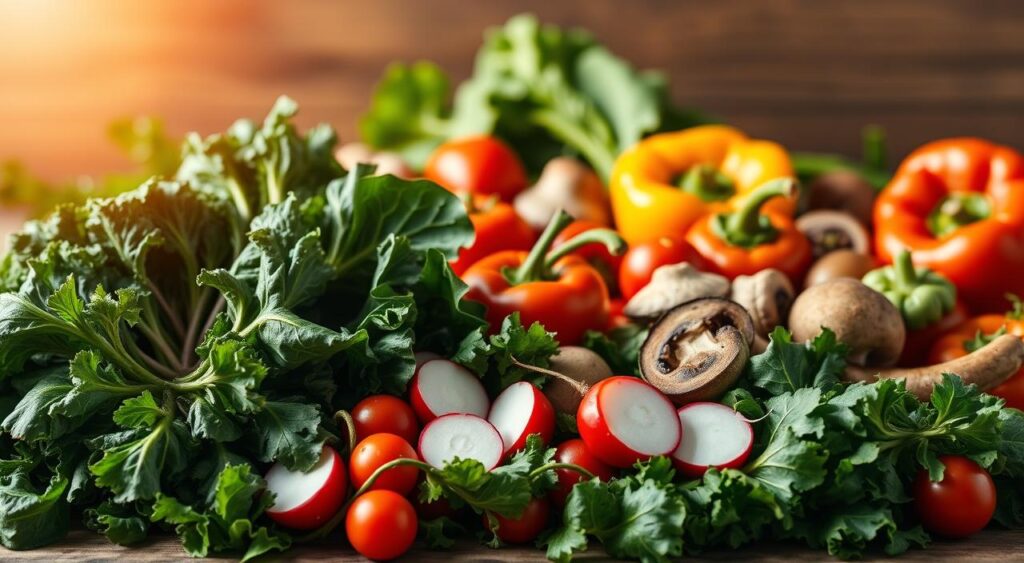
Probiotic and Prebiotic Powerhouses
To further enhance your gut health, include probiotic and prebiotic powerhouses in your stir fry. Fermented ingredients like miso or kimchi introduce beneficial probiotics, while mushrooms such as shiitake contain beta-glucans that strengthen immune function and provide prebiotic benefits. Adding these to your stir fry can significantly boost your digestive wellness.
Anti-Inflammatory Ingredients
Anti-inflammatory ingredients play a crucial role in maintaining gut health. Garlic and ginger serve dual purposes as flavor enhancers and powerful gut health supporters, with antimicrobial and anti-inflammatory properties. Including leafy greens like bok choy and spinach can provide essential nutrients that feed beneficial gut bacteria. Pair these with lean proteins like grass-fed beef or organic chicken for a well-rounded, gut-friendly meal.
Essential Equipment and Preparation for Perfect Stir Fry
Before you begin cooking your stir fry, it’s essential to have the right equipment and preparation in place. A proper stir fry requires the right tools to achieve the high heat needed to cook ingredients perfectly.
Choosing the Right Pan
A large skillet or wok is essential for a great stir fry. Use your largest skillet or wok; flat-bottomed woks are great if you stir-fry often, but a 12- to 14-inch skillet works just as well. The wide surface area allows vegetables to sear rather than steam, preserving their texture and nutritional value. 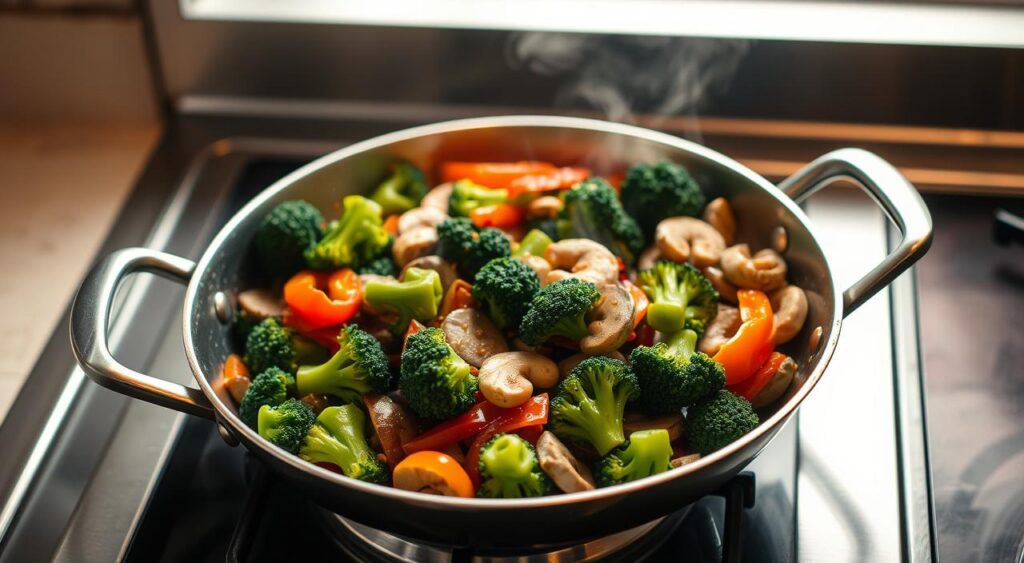
Prep Before You Cook
Proper preparation before cooking is crucial as stir fry happens quickly. Having all ingredients chopped and arranged in order of cooking prevents overcooking. It’s also important to preheat the wok or skillet before beginning. You can test if it’s hot enough by flicking in a few drops of water—they should evaporate within 1-2 seconds of contact. Choosing the right oil is also crucial; opt for oils with high smoke points like avocado oil that remain stable at high heat.
The Anatomy of a Gut-Friendly Stir Fry Sauce
The key to a great stir fry lies in its sauce, which can be both delicious and gut-friendly. A well-crafted stir fry sauce not only enhances the flavor of your vegetables and protein but also supports digestive health.
Fermented Ingredients for Digestive Health
Incorporating fermented ingredients like miso paste into your stir fry sauce can add beneficial probiotics. These probiotics help maintain a healthy gut microbiome, supporting digestion and overall gut health. Using coconut aminos or tamari instead of traditional soy sauce can also be beneficial for those with soy sensitivities, maintaining the umami flavor profile.
Balancing Flavors Without Irritating the Gut
Balancing flavors in your stir fry sauce is crucial. Using natural sweeteners like honey or maple syrup can provide a gentler option for sensitive digestive systems compared to refined sugars. Adding a tablespoon of apple cider vinegar or rice vinegar can enhance brightness while supporting digestive enzyme production. Fresh ginger and garlic provide anti-inflammatory benefits, soothing the digestive tract.
| Ingredient | Benefit |
|---|---|
| Sesame Oil | Rich flavor and healthy fats for nutrient absorption |
| Chicken Broth | Gut-healing amino acids from quality sources |
| Fermented Ingredients (Miso Paste) | Beneficial probiotics for gut health |
| Fresh Ginger and Garlic | Anti-inflammatory benefits for the digestive tract |
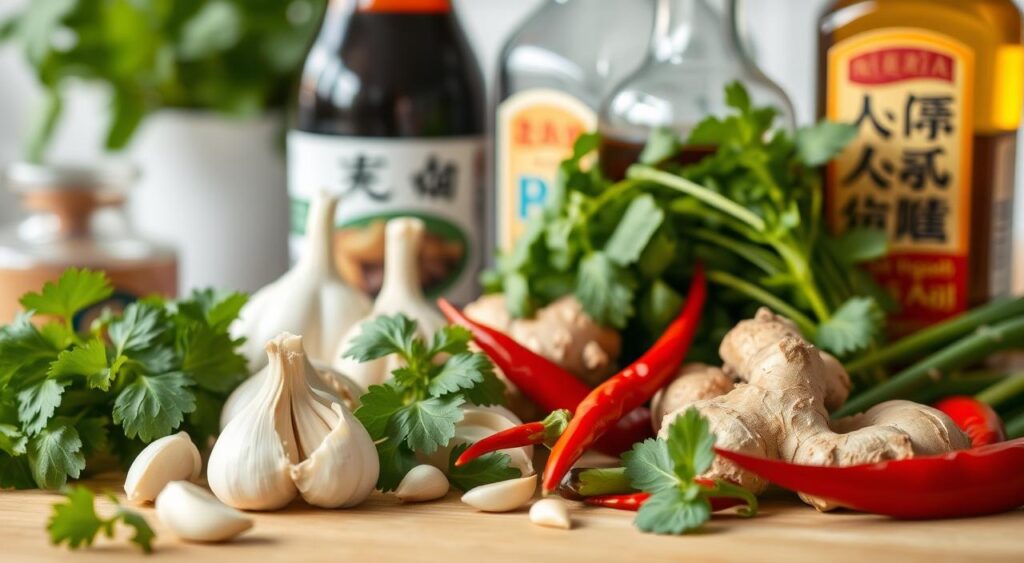
To make a gut-friendly stir fry sauce, whisk together corn starch and water, then add ingredients like chicken broth, soy sauce, honey, and toasted sesame oil. Set aside your prepared sauce before cooking to add it at the right moment for optimal flavor and digestive benefits.
3 Quick and Healthy Stir Fry Recipes for Gut Health
Gut health meets flavor in these three quick and healthy stir-fry recipes designed to support your digestive wellness. Each recipe is carefully crafted to incorporate ingredients that not only tantalize your taste buds but also provide significant gut health benefits.
Ginger-Turmeric Chicken with Broccoli and Bell Peppers
This recipe combines the anti-inflammatory properties of turmeric with the gut-soothing effects of ginger, creating a powerful digestive support stir-fry. The addition of broccoli provides sulforaphane, a compound that supports detoxification pathways in the gut, while bell peppers add vitamin C, supporting gut barrier integrity.
To make this dish, sauté chicken in a mixture of sesame oil and soy sauce, then add sliced ginger and turmeric. Include a cup of broccoli and sliced bell peppers, and serve over brown rice or cauliflower rice.
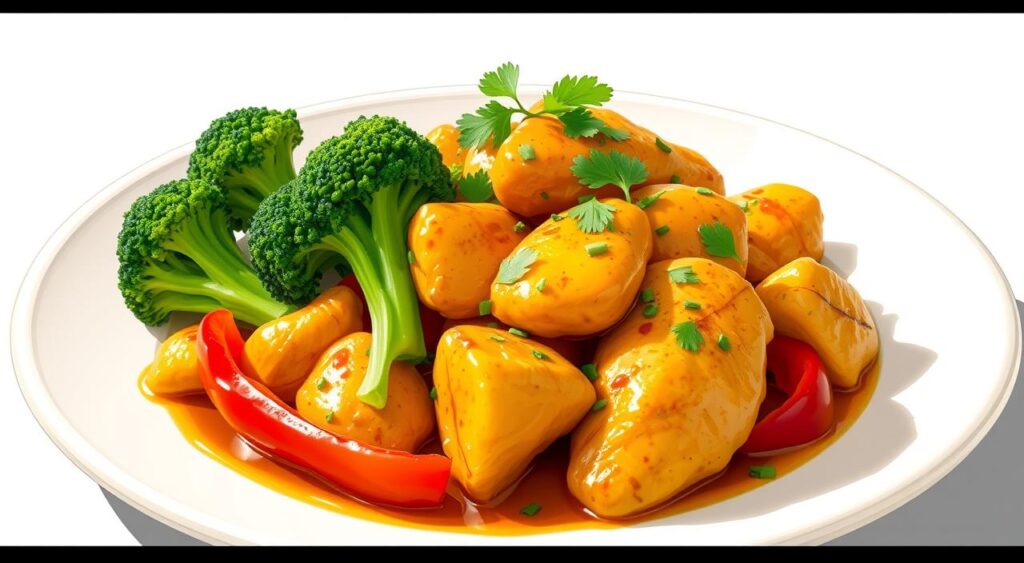
Prebiotic Vegetable Stir Fry with Garlic and Mushrooms
This vegetable-focused recipe is rich in prebiotics, thanks to the inclusion of garlic and mushrooms. Garlic serves as a powerful prebiotic, feeding beneficial gut bacteria, while mushrooms provide beta-glucans that strengthen gut immunity.
To prepare, sauté a variety of vegetables including garlic and mushrooms in sesame oil. Season with soy sauce and serve over a bed of cauliflower rice for a gut-friendly meal.

Gut-Healing Beef and Bok Choy Stir Fry
The Gut-Healing Beef and Bok Choy Stir Fry features grass-fed beef, providing the amino acids necessary for intestinal repair. Bok choy is rich in antioxidants that reduce inflammation in the digestive tract.
This recipe uses a beef stir-fry sauce made with bone broth, adding gut-healing glycine and collagen. Sauté beef and bok choy in sesame oil, then serve with a side of steamed vegetables or over cauliflower rice.
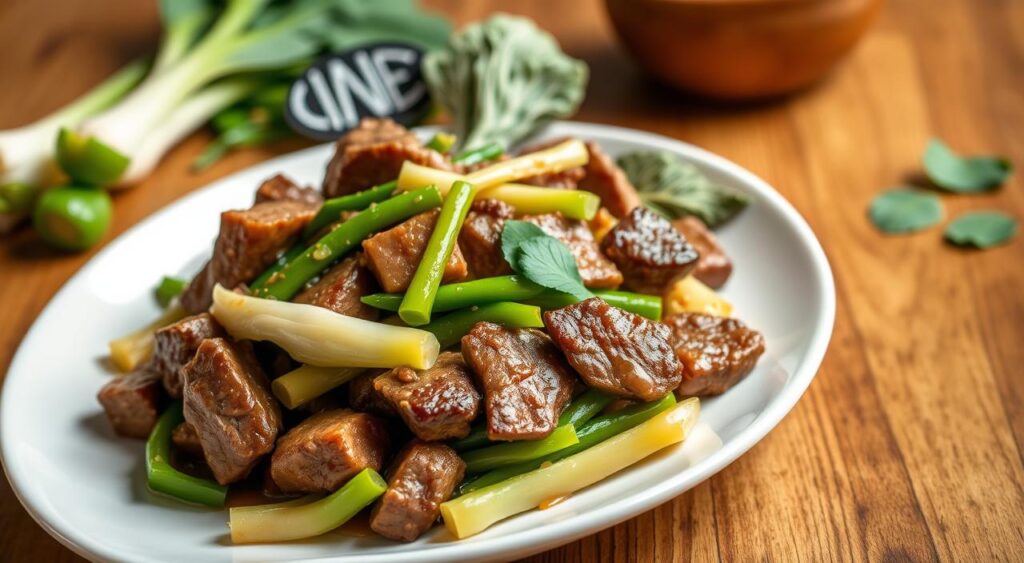
These stir-fry recipes are designed to be gentle on sensitive digestive systems while delivering robust flavors and satisfying textures. They can be served over brown rice or cauliflower rice, making them adaptable to various dietary needs.
Mastering the Stir Fry Technique for Maximum Nutrition
To get the most out of your stir fry, mastering the technique is crucial. A well-cooked stir fry not only tastes great but also retains the nutrients from the ingredients.
The Proper Cooking Order
Cooking your ingredients in the right order is essential for a perfect stir fry. Start by partially cooking your protein in a hot large skillet before setting it aside. Next, add the hardy vegetables like broccoli and carrots to the skillet and cook until they are caramelized. Then, add aromatics like garlic and ginger, cooking until fragrant.
Timing Tips for Perfectly Cooked Vegetables
Vegetables should be cooked for the right amount of time to preserve their nutritional value. Most veggies should be cooked for 2-3 minutes. Add your stir fry sauce and bring it to a quick boil to activate the thickening agent. Return your protein to the pan and ensure it’s cooked through. For a chicken stir fry, make sure the chicken pieces are uniform in size for even cooking.
Meal Prep and Storage Tips for Gut-Friendly Stir Fry
Making meal prep a part of your routine can help you enjoy gut-friendly stir fry any day of the week. By preparing components ahead of time, you can save valuable time during busy weeknights while sticking to your digestive health goals.
Make-Ahead Components
To get started, you can prepare your stir fry sauce up to 5 days in advance and store it in an airtight container in the refrigerator. Chop vegetables like broccoli, bell peppers, and carrots ahead of time and store them in separate containers to maintain their freshness and nutritional value.
Proper Storage for Optimal Freshness
When storing leftover stir fry, cool it completely before refrigerating to prevent bacterial growth that could upset your gut. Properly stored stir fry can maintain its nutritional benefits and flavor for 3-4 days in the refrigerator.
| Meal Prep Component | Storage Tip | Reheating Tip |
|---|---|---|
| Stir Fry Sauce | Refrigerate for up to 5 days | Reheat gently |
| Chopped Vegetables | Store in separate containers | Add a splash of water when reheating |
| Cooked Stir Fry | Cool completely before refrigerating | Reheat in the microwave or skillet |
By following these meal prep and storage tips, you can enjoy a quick, healthy, and gut-friendly stir fry any day of the week. Consider freezing individual portions of your stir fry recipe for emergency gut-healthy meals when time is limited.
Conclusion: Incorporating Gut-Healthy Stir Fry into Your Weekly Routine
Embracing gut-friendly stir fry recipes can be a game-changer for your digestive wellness journey. By incorporating these quick and healthy meals into your weekly dinner rotation, you’ll be supporting your gut health with diverse vegetables and nutrient-rich ingredients.
Start with one chicken stir fry dinner per week and explore different combinations, like adding broccoli or beef, to keep your meals interesting. Experiment with seasonal vegetables to maintain a diverse gut microbiome and consider theme nights to build consistency in your gut health journey.
FAQ
What are the best vegetables to use in a stir fry for gut health?
You can include fiber-rich vegetables like broccoli, bell peppers, and carrots, which support digestive wellness. Other options are snow peas, green beans, and bok choy, which are gentle on the gut.
Can I use pre-made stir fry sauce, or should I make my own?
While pre-made stir fry sauce can be convenient, making your own sauce allows you to control the ingredients and avoid potential gut irritants. You can create a gut-friendly sauce using fermented ingredients like soy sauce and ginger.
How do I cook chicken or beef for a stir fry to ensure food safety?
To ensure food safety, cook your protein to the recommended internal temperature: 165°F for chicken and 145°F for beef. Use a thermometer to check the temperature, and make sure to handle the protein safely during preparation.
What is the best way to store leftover stir fry?
To maintain optimal freshness, store leftover stir fry in an airtight container in the refrigerator within two hours of cooking. Reheat the stir fry to 165°F before consuming, and consume within three to four days.
Can I customize stir fry recipes to suit my dietary needs?
Absolutely, you can modify stir fry recipes to accommodate your dietary requirements. For example, you can swap out ingredients, adjust the amount of soy sauce, or add other gut-friendly ingredients to suit your needs.
